The Monotheism of Akhenaten
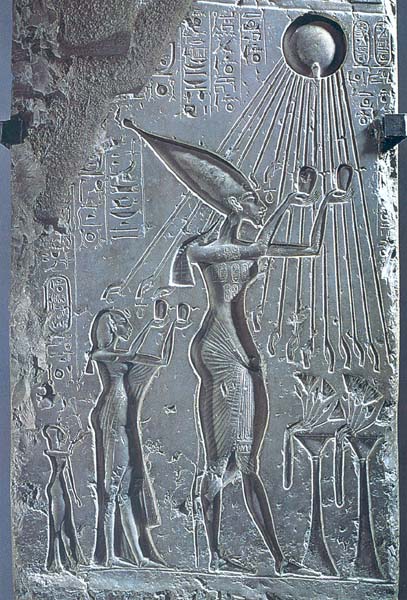
Monotheism, polytheism and henotheism are constructs of the Judeo-Christian tradition. They manifest a mindset quite different from that of ancient man. These concepts, along with such pejorative categories as heathens, pagans and idolaters, reflect a rationalization of history that seems natural to us but was not characteristic of ancient cultures. The use of such terms assumes a period of ignorance followed by a period of revelation. The revelation is always thought to have occurred in the remote past. How the Supernatural operates in the present, long after the revelation, is never really addressed.
For ancient man, the situation was quite different. For him, the Supernatural never ceased to interact with the human community and the cosmos. There was no great revelation. If there was ever a break between time past and present, it was marked by creation itself: chaos before, order afterwards.
It would never have occurred to an ancient Egyptian to postulate the Supernatural as a monad—a unitary, intellectually superior emanation. Much less would it have occurred to him to suppose that his eternal salvation depended on the recognition of such a monad. One man might choose to worship this god or that; another might even hold, for whatever reason, that other gods did not exist. But this was not important for an ancient Egyptian. He could not have cared less.
An ancient Egyptian would have objected only when some belligerent proselytism threatened to affect the lives of the populace, perhaps by tearing down the old temples and their landed estates or by prohibiting ordinary forms of worship. But even then, his objection would have had nothing to do with how many gods were worshiped.
This can be illustrated by the case of the pharaoh Akhenaten (1352–1336 B.C.E.), who, in modern times, is sometimes called the first monotheist. After Akhenaten’s death, Egyptians immediately reverted to their old religious norms. Akhenaten was then labeled a “rebel” and a “doomed one” because he had overthrown the socioeconomic system and had almost disrupted the running of the state. But no one back then ever called him anything like “monotheist” (whatever lexical form that would have conjured up in the Egyptian language), and certainly no pejorative was ever hurled at him for espousing one god.
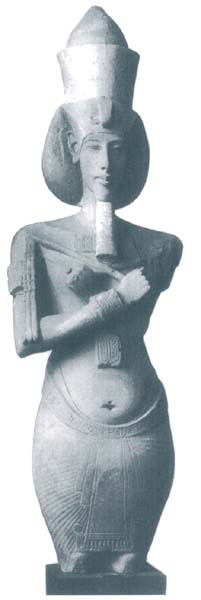
The Egyptians, like most ancient peoples, experienced the Supernatural as infinite plurality. It impinged upon their lives in multifarious ways, from beneficial to inimical. It consisted of innumerable wills and personalities.
From late prehistoric times, this infinite plurality, this Supernatural, translated itself into a series of gods, powers of heaven and earth, and numina—all organized at first on a parochial level as a roster of town gods and later as gods who operated in a wider domain. Clever Roman satirists and epigrammatists like Juvenal and Martial might scoff at the myriad of animal and “kitchen-garden” gods that “demented Egypt” worshiped, but the Egyptians were simply acknowledging that the Supernatural—wherever perceived—interjects itself into the affairs of humanity.
With the advent of the sophisticated pharaonic state in the third millennium B.C.E., the godly pantheon became highly centralized and tightly ranked. Notions of hierarchy and subordination were introduced. Family relationships and specifically assigned functions insinuated themselves into the world of the divine.
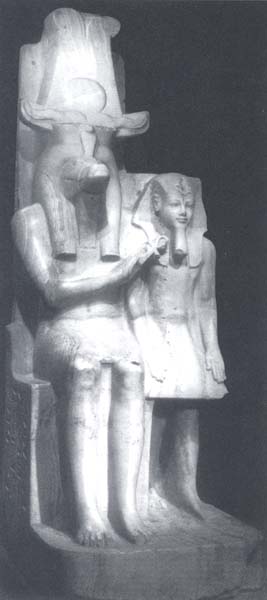
That one pre-eminent power should ape the world of men and become King of the Gods was only to be expected. Where he came from was immaterial. That he might team up with solar and chthonic power to become the triune essence of all that exists— the sun, the latent power of the underworld and the earth—is of considerable interest in the evolution of human speculation about the great imponderables. But it is not monotheism!
One unknown Memphite priest, at a remote period of history, perceived the myriad of deities of the Egyptian pantheon as immediate avatars of an underlying One. This One was “in every body, of all living things, animating them by thinking and enunciating [His] will.” This is a much more profound break with the past, a true quantum leap as it were; but it is not monotheism either.
Monotheism does not appear through amalgamation and syncretism but rather through the annihilation of other gods. Other divine entities are not simply taken on board and integrated into the pantheon; they are thrown over and left to drown. If they must be acknowledged, it is only done by a kind of deconsecration that demotes them to the status of demons and insists that they were never anything else. They are to be destroyed and plastered over. Their worshipers are attacked, and if they cannot be slaughtered like the prophets of Ba‘al, they are ridiculed, mocked and vilified.
Most importantly, salvation comes only through an unconditional surrender of intelligence to the Supernatural, who does not need to explain his actions or to reveal himself, except to a single individual.
Small wonder that the three great monotheisms we are familiar with celebrate themselves in hymns larded with military jargon. Small wonder that the Egyptians, when eventually confronted by the faceless, unidentifiable, vindictive Judeo-Christian God, rejected him and declared the religiosity—or irreligiosity—of his fanatical followers atheism.
Prior to the Greco-Roman period, the only native Egyptian that we know of who promoted a “one-godism” was Pharaoh Amenophis IV, known as Akhenaten. The expected belligerent streak shows through in his treatment of Amun, the chief god of the Egyptian pantheon. That Akhenaten did not venture on a campaign of forceful proselytism shows only that he did not feel the need: The great Unwashed would follow him blindly since he was their All-in-All. And by the time they realized the folly of Akhenaten’s program, he was almost dead anyway.
Egyptian Kings: Before and After Akhenaten
| XVIIIth Dynasty (B.C.E.) | |
|---|---|
| Ahmose | 1550–1525 |
| Amenophis I | 1525–1504 |
| Thutmose I | 1504–1492 |
| Thutmose II | 1492–1479 |
| Thutmose III | 1479–1425 |
| Hatshepsut (co-regent with Thutmose III) |
1479–1457 |
| Amenophis II | 1427–1400 |
| Thutmose IV | 1400–1390 |
| Amenophis III | 1390–1352 |
| Amenophis IV (Akhenaten) |
1352–1336 |
| Smenkhkare | 1338–1336 |
| Tutankhamun | 1336–1327 |
| Aya | 1327–1323 |
| Haremhab | 1323–1295 |
| XIXth Dynasty (B.C.E.) | |
| Ramesses I | 1295–1294 |
| Seti I | 1294–1279 |
| Ramesses II | 1279–1213 |
| Merneptah | 1213–1203 |
| Seti II | 1200–1194 |
| Siptah | 1194–1188 |
| Tewosret | 1188–1186 |
Akhenaten, the second son of Amenophis III and his royal wife Tiye, was born either towards the end of the 15th century or early in the 14th century B.C.E. These were halcyon days for Egypt and her empire. Amenophis III sat in imperial splendor over all the lands between Karoy in the Sudan and the Euphrates in Mesopotamia, a tract today occupied by all or parts of seven modern states. Amenophis’s court became a byword over the known world for its luxury; his reign gave rise to an aristocratic elite such as Egypt had never seen. Amenophis III was proud that his civil service appointments came “from the most elite and the choicest of the whole land.” According to an inscription on the Third Pylon of the Temple of Amun at Karnak, Akhenaten congratulated himself: “I did not appoint any who did not have a respectable lineage, reaching back over generations.” The art he favored was supercharged with a symbolism expressive of his divinity. He dubbed himself “the Dazzling Sun-disc”—a veritable Louis XIV, le roi soleil. The revenues from the empire transformed Egypt into the richest country on earth, a land “in which gold is as plentiful as dust.”
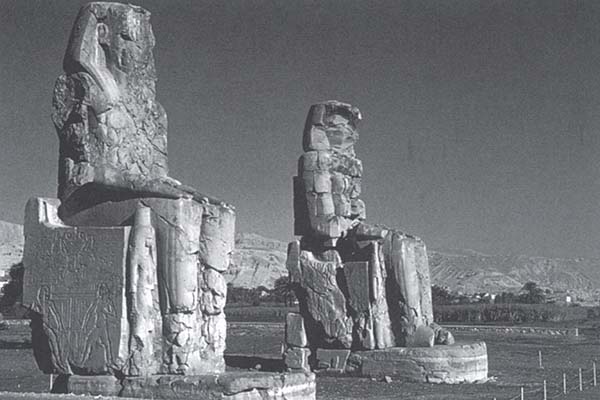

Akhenaten succeeded his father and ruled for 17 peaceful years. Despite the prosperity of his reign, following his death there was a general destruction and concealment of his monuments as the populace returned to the old ways. Until recently, however, there has been scarce archaeological or textural material providing information about the pharaoh’s reign, or about the man himself.
But now Akhenaten is gradually coming into sharper focus through the careful recovery of bits and pieces of evidence. Three projects in particular are providing this material: the work of the Centre Franco-egyptien in recovering lost relief fragments of Akhenaten’s temples from secondary locations where they were used; the renewed British excavations at Tell el-Amarna, Akhenaten’s capital, which he called Akhetaten; and my excavation of Akhenaten’s earliest temple at Karnak, in Thebes. As a result, the following generalizations can now be made with unassailable conviction:
First, there is no evidence of any co-regency of Akhenaten and his father. Co-regency has in the past been advanced to explain, rather simplistically, the handful of memorials dedicated to Amenophis III at Tell el-Amarna.
Second, there is no evidence of any foreign influence on Akhenaten’s revolutionary program of one-godism. Even though his grandfather was Nubian, Akhenaten himself was brought up at the Egyptian capital of Thebes. There is no reason to believe that his wife, Nefertity, was anything but Egyptian. Of his mentors referred to in the records, his uncle served as a priest of the sun god, Aten; his father’s vizier was an Egyptian aristocrat; and his childhood tutor was a court flunky who later became Akhenaten’s butler. In short, all the ingredients of his “cult” of the Sun-disc—the elevation of Aten to supreme and sole god—can be found on Egyptian soil.
Third, although Akhenaten stated that Thebes and its people were uncongenial to him, he nevertheless celebrated a jubilee sometime during his five-year reign there. In Egypt, jubilee festivals, celebrated as far back as the First Dynasty (3100–3000 B.C.E.), sought to reaffirm the legitimacy of the king’s reign; both gods and human dignitaries from all over the kingdom were invited to the festival and convened in a great complex of buildings erected specially for the occasion. In connection with his jubilee, Akhenaten erected four large “sun temples” in Thebes. The masonry from Akhenaten’s Theban temples was recycled by later generations; between 15 and 20 percent of the relief decoration is still extant in secondary use. By contrast, less than one percent of the original inscriptional material has survived from Amarna (Akhetaten), which served as Akhenaten’s capital from his fifth year onwards. It is therefore the earliest period of Akhenaten’s reign, his Theban years, that offer the best evidence of the new ideas percolating in his brain.
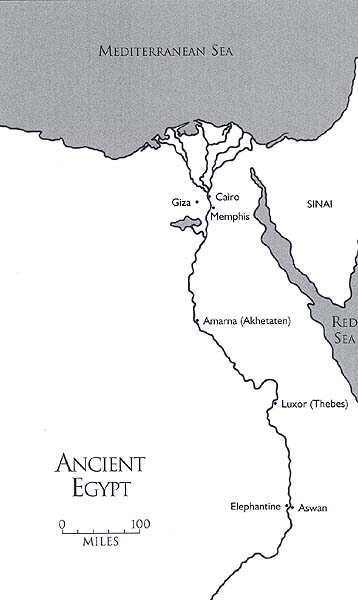
Fourth, Akhenaten’s decision to concentrate his worship on the divine Sun-disc (Aten) cannot be separated, at least in time, from his decision to change the style of Egyptian art. For a brief period at the beginning of the reign, both Aten and the pharaoh himself were depicted in traditional guise; even Amun was allowed to retain his traditional place in the divine iconography. Akhenaten soon modified the artistic canon, however, to accommodate the Sun-disc and its relationship to himself. Above all, Akhenaten had himself represented in a way that, even by the ancients, was not considered flattering: His skull seems malformed, with a lanternlike jaw and an over-heavy head on an elongated neck; and spindly legs support his curiously feminine torso.
One senses that the key to unlocking the mysteries of his reign may lie in our understanding of this peculiar image. Interpretations have veered wildly; some consider him a woman in disguise, while others describe him as a eunuch brought back from the Sudan. Another interpretation is that Akhenaten suffered from a congenital ailment; the chief candidate has been Froehlich’s syndrome—but that poses more problems than it solves. The most recent suggestion is that Akhenaten suffered from Marfan’s syndrome. The ocular, cardiovascular and musculoskeletal defects of this syndrome indeed match Akhenaten to a T. But this suggestion poses more problems than it solves. In particular, Froehlich’s syndrome almost invariably results in early sterility and reduced intelligence; but Akhenaten was neither childless (we know he had at least six daughters) nor mentally challenged.
One school of thought has dismissed physical causes in favor of a symbolic interpretation: Akhenaten decreed that he should be thus depicted simply to convey the idea of himself as an androgynous or hermaphroditic fertility figure—symbolizing the pharaoh’s status as father and mother of all mankind. In fact, precisely this kind of androgynous figure does exist in Egyptian art, both before and after Akhenaten, and for this very purpose. If Akhenaten had wanted to depict himself as an androgynous parent of all, he surely would have appropriated the traditional imagery. But, alas, Akhenaten’s images look nothing like these other depictions, suggesting that Akhenaten was up to something else.
Fifth and finally, Akhenaten’s new program involved the worship of one god (the Sun-disc Aten), the graphic and verbal expressions of which were iconoclastic. That is, the traditional use of a ubiquitous, complex symbolism and extended metaphor in describing the Supernatural was given up; even in the minor decorative arts, images smacking of polytheistic symbolism were abandoned.
Some who deny Akhenaten’s one-godism have pointed to the occasional use in his royal inscriptions of the word “gods,” as well as the divine names Hathor, Shu, Re and Horus, along with Aten. But this argument is specious. Most, if not all, references to these other gods occur very early in Akhenaten’s reign, when experimentation was rife, even in the king’s own thinking. At that time, sculptors and lector-priests were trying to understand the king’s directives, and so tangential interpretations might be expected. The references to Hathor and “the gods” are found in depictions prepared for the jubilee, which Akhenaten celebrated in his third year and which classically centered upon a conclave of all the gods of Egypt. That the references are exceptional can be shown by the fact that Akhenaten did his best to expunge the gods everywhere in the ritual: The numerous shrines, once filled by the numina from Upper and Lower Egypt, were filled by the Sun-disc alone; the hymn to Hathor was bowdlerized to remove all hateful symbolism of the gods. Finally, the solar names Re-harakh Te and Shu appear almost entirely in the new didactic name Akenhaten gave to his new god, and here they have been transmogrified from names into common nouns meaning “sun” and “light”: “Live the Sun-Horus of the Horizon, he who rejoices in the horizon in his name of ‘Light-which-is-in-the-Sun-disc.’”
The most revealing text about the nature of Akhenaten’s new god and his motivation in introducing him is now part of the tenth pylon at Karnak. Although this pylon was erected by Pharaoh Haremhab about a generation after Akhenaten’s death, it includes recycled masonry from a gate built by the late heretic and then dismantled. Where the gate originally stood is not clear, but the style of its decoration suggests that it was put up very early in Akhenaten’s reign, before his revolutionary art was introduced. Two blocks clearly belonged to a long inscription written in columns. Although 14 columns are partially preserved, neither the first nor the last is extant on the blocks. As a result, not a single complete sentence is preserved either within a column or from column to column. Nonetheless, a progression of thought and content can be discerned.
It is quite striking. The text begins with Akhenaten declaiming that all of the other gods have failed and “ceased” to be effective. But the next few columns of text go further, celebrating another god who has not “ceased.” This is a god “[who himself gave birth] to himself, and no one knows the mystery of […] He [go]es where he pleases and they know not [his] g[oing].” Akhenaten describes his newly adopted god as absolutely unique and located in the heavens. Numerous vignettes, also carved on Akhenaten’s dismantled gate, make it clear that the god in question is Re, the Horizon-Horus, or the great sun god. This god is mysterious, celestial and self-engendered, and his creation is exalted.
The inscription on the tenth pylon shows not only that Akhenaten worshiped one god (as we already knew) but that he countenanced the existence of only one god. Column 13 of the inscription gives us a new version of a formula Akhenaten is quite fond of: “How matchless is his god!” Columns 8–11 stress the new god’s ineffable quality and suggest Akhenaten’s special relationship with the deity—which Akhenaten would reiterate again and again in references to the Sun-disc as “his father” and to himself as the “fair child of the Sun-disc.” The intimacy of this relationship is often graphically illustrated: The rays of light from the Sun-disc end in human-like hands that fondle and protect the beloved son, Akhenaten, and his wife, Nefertity.
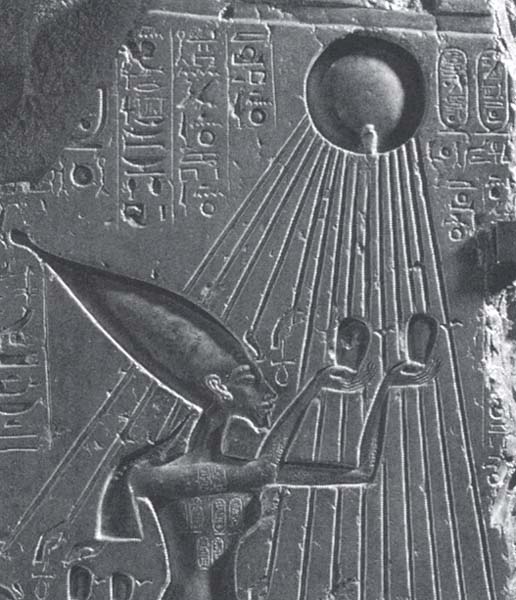
Given the extremely fragmentary nature of the text, however, several problems remain. We would love to know what exactly is implied by the verb
Akhenaten’s exaltation of the Sun-disc as supreme, self-begotten and all-powerful leads us to expect to find intolerance toward elements that did not fit into his thinking. And we do. His attempted destruction of Amun—by defacing the god’s name and image—is well known. Less well known is the fact that Akhenaten banished Amun’s high-priest to work in the quarries. While there is no evidence that Akhenaten moved actively to close the temples of Amun, he did divert the income from these temples to his new Sun-disc shrines. His boyhood tutor, butler and master of alimentation, Parennefer, threatened those who refused to comport with the new program. An inscription on Parennefer’s Theban tomb reads: “Now the Sun knows which is the servant that is diligent with respect to offerings. The servant who is not diligent with respect to the offerings of the Sun-disc gives himself over into thy [the king’s] power; for the grain imposts of every other god are measured merely in small amounts, but for the Sun-disc they are measured in superabundance.”
Akhenaten was clearly a monotheist. All the well-known ingredients are present: the revelation-cum-teaching, the belligerent iconoclasm, the denial of the plurality of the Supernatural, the anathematization of other “gods,” the purging of forms of religious expression. He believed in a single, universal god, Aten, who had created the world and who continued to affect the world through His active presence. But Akhenaten’s religion did not go much further; he promulgated his belief in the supreme Sun-disc by having temples built and hymns composed—and by disfiguring the “false” gods—and that was largely that.
Before much of the archaeological evidence from Thebes and from Tell el-Amarna became available, wishful thinking sometimes turned Akhenaten into a humane teacher of the true God, a mentor of Moses, a Christlike figure, a philosopher before his time. But these imaginary creatures are now fading away one by one as the historical reality gradually emerges. There is little or no evidence to support the notion that Akhenaten was a progenitor of the full-blown monotheism that we find in the Bible. The monotheism of the Hebrew Bible and the New Testament had its own separate development—one that began more than half a millenium after the pharoah’s death.

Monotheism, polytheism and henotheism are constructs of the Judeo-Christian tradition. They manifest a mindset quite different from that of ancient man. These concepts, along with such pejorative categories as heathens, pagans and idolaters, reflect a rationalization of history that seems natural to us but was not characteristic of ancient cultures. The use of such terms assumes a period of ignorance followed by a period of revelation. The revelation is always thought to have occurred in the remote past. How the Supernatural operates in the present, long after the revelation, is never really addressed.
For ancient man, the situation was quite different. For him, the Supernatural never ceased to interact with the human community and the cosmos. There was no great revelation. If there was ever a break between time past and present, it was marked by creation itself: chaos before, order afterwards.
